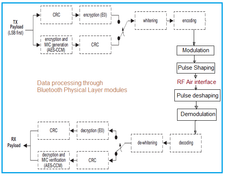Bluetooth Channel Frequency List and Range Explained
Advertisement
Bluetooth operates in the 2.4 GHz ISM band, dividing the spectrum into multiple channels for robust and interference-free communication. This document provides an overview of Bluetooth frequency allocations, covering channel classifications for different Bluetooth versions, frequency hopping, and channel utilization. The bluetooth channels list is a crucial reference for understanding how Bluetooth technology allocates and uses the radio frequency spectrum.
The Bluetooth frequency range spans from 2.400 GHz to 2.4835 GHz. This range is divided into 79 channels, each with a 1 MHz bandwidth. In Bluetooth Low Energy (BLE), there are 40 channels, each with a 2 MHz bandwidth.
The 79 channels with 1 MHz bandwidth are used across the US, Europe, and many other countries. Japan, Spain, and France utilize a smaller set of 23 Bluetooth channels.
The following table outlines the Bluetooth channel frequencies used in different regions:
| Region | Bluetooth Frequency range | Bluetooth Channels |
|---|---|---|
| US, Europe, Rest of World | 2.4 to 2.4835 GHz | f=2.402 + n, MHz (n = 0 to 78) |
| Japan | 2.471 to 2.497 GHz | f = 2.473 + n, MHz (n = 0 to 22) |
| Spain | 2.445 to 2.475 GHz | f = 2.449 + n, MHz (n = 0 to 22) |
| France | 2.4465 to 2.4835 GHz | f = 2.454 + n , MHz (n = 0 to 22) |
Bluetooth Channels List
Below are the absolute frequencies for each of the 79 Bluetooth channels:
| Channel No. | Frequency (MHz) | Channel No. | Frequency (MHz) |
|---|---|---|---|
| 0 | 2402 | 40 | 2442 |
| 1 | 2403 | 41 | 2443 |
| 2 | 2404 | 42 | 2444 |
| 3 | 2405 | 43 | 2445 |
| 4 | 2406 | 44 | 2446 |
| 5 | 2407 | 45 | 2447 |
| 6 | 2408 | 46 | 2448 |
| 7 | 2409 | 47 | 2449 |
| 8 | 2410 | 48 | 2450 |
| 9 | 2411 | 49 | 2451 |
| 10 | 2412 | 50 | 2452 |
| 11 | 2413 | 51 | 2453 |
| 12 | 2414 | 52 | 2454 |
| 13 | 2415 | 53 | 2455 |
| 14 | 2416 | 54 | 2456 |
| 15 | 2417 | 55 | 2457 |
| 16 | 2418 | 56 | 2458 |
| 17 | 2419 | 57 | 2459 |
| 18 | 2420 | 58 | 2460 |
| 19 | 2421 | 59 | 2461 |
| 20 | 2422 | 60 | 2462 |
| 21 | 2423 | 61 | 2463 |
| 22 | 2424 | 62 | 2464 |
| 23 | 2425 | 63 | 2465 |
| 24 | 2426 | 64 | 2466 |
| 25 | 2427 | 65 | 2467 |
| 26 | 2428 | 66 | 2468 |
| 27 | 2429 | 67 | 2469 |
| 28 | 2430 | 68 | 2470 |
| 29 | 2431 | 69 | 2471 |
| 30 | 2432 | 70 | 2472 |
| 31 | 2433 | 71 | 2473 |
| 32 | 2434 | 72 | 2474 |
| 33 | 2435 | 73 | 2475 |
| 34 | 2436 | 74 | 2476 |
| 35 | 2437 | 75 | 2477 |
| 36 | 2438 | 76 | 2478 |
| 37 | 2439 | 77 | 2479 |
| 38 | 2440 | 78 | 2480 |
| 39 | 2441 | - | - |
Note: For BLE, there are 40 channels spaced 2 MHz apart, ranging from 2402 MHz to 2480 MHz. BLE uses 3 advertising channels (37, 38, and 39) and 37 data channels. The advertising channels are strategically positioned to avoid frequencies commonly used by Wi-Fi.
Conclusion
Understanding the Bluetooth channel frequency list is crucial for optimizing device performance and avoiding interference in crowded frequency bands. With this detailed breakdown of channel allocations and usage, you can ensure efficient Bluetooth communication and avoid potential disruptions in wireless connectivity.
Advertisement
 RF
RF

